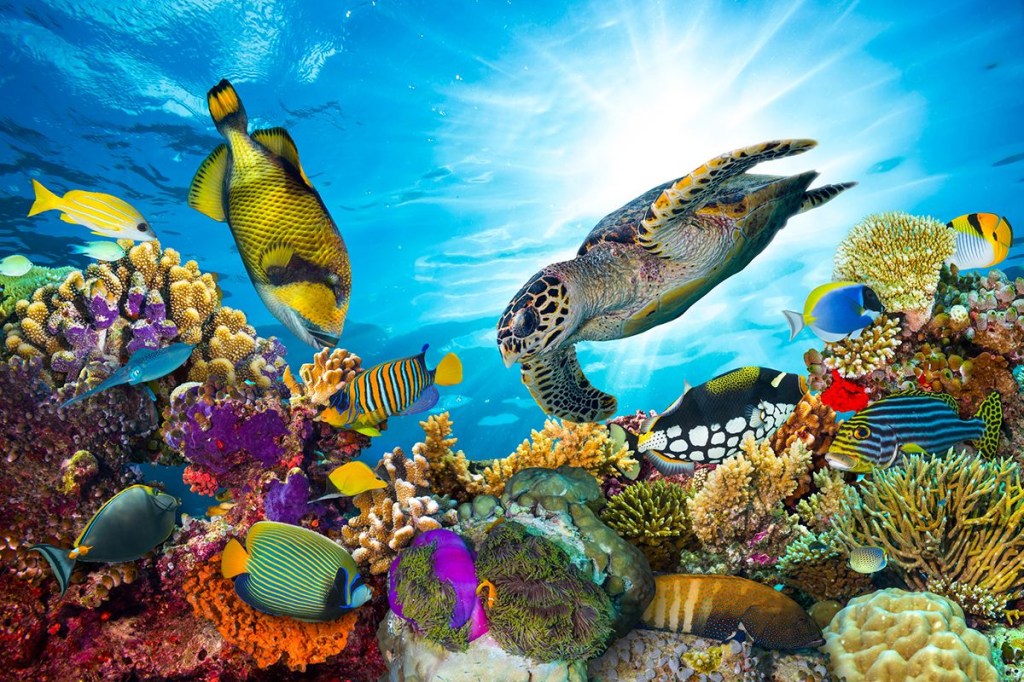Captivating Ocean Wildlife Images: Dive Into The Majestic World Of Marine Life Now!
Exploring the Wonders of Ocean Wildlife Images
Ocean wildlife images have the power to transport us to a world beneath the surface of the sea, captivating our imagination and offering a glimpse into the wonders of marine life. As an avid lover of photography and a nature enthusiast, my fascination with ocean wildlife images began when I stumbled upon a breathtaking photograph of a majestic humpback whale leaping out of the water. From that moment on, I embarked on a journey to explore and appreciate the beauty and diversity of marine creatures through the lens of talented photographers.
What are Ocean Wildlife Images?
Ocean wildlife images are visual representations captured by skilled photographers that showcase the diverse marine life found in our oceans. These images depict a wide range of subjects, including vibrant coral reefs, playful dolphins, graceful sea turtles, mysterious deep-sea creatures, and powerful predators such as sharks and whales. Through these images, we gain a deeper understanding and appreciation for the delicate balance of life that exists beneath the waves.
2 Picture Gallery: Captivating Ocean Wildlife Images: Dive Into The Majestic World Of Marine Life Now!


Who Captures Ocean Wildlife Images?
Ocean wildlife images are captured by a dedicated community of photographers who possess a deep passion for marine life and the skills to capture its beauty through their lenses. These individuals undergo extensive training and invest countless hours to master the art of underwater photography. Their commitment to showcasing the wonders of the ocean allows us to witness moments that would otherwise remain hidden from our view.
When and Where to Find Ocean Wildlife Images?

Image Source: juniqe.com
Ocean wildlife images can be found in various forms, such as online platforms, photography exhibitions, magazines, and books. The availability of these images is not limited by time or location, as photographers tirelessly venture into different oceans across the globe to capture awe-inspiring moments. Whether it’s the crystal-clear waters of the Maldives, the rich biodiversity of the Great Barrier Reef, or the frigid depths of the Arctic, these photographers brave challenging conditions to bring us closer to the wonders of the underwater world.
Why are Ocean Wildlife Images Important?
Ocean wildlife images play a crucial role in raising awareness about marine conservation. By visually showcasing the magnificent creatures and ecosystems that inhabit our oceans, these images inspire us to protect and preserve these delicate environments. They serve as a reminder of the fragility of marine life and the urgent need to take action to mitigate the threats they face, such as pollution, overfishing, and climate change.
How to Capture Stunning Ocean Wildlife Images?
Ocean wildlife images require a combination of technical skills, patience, and a deep understanding of marine life. Photographers utilize specialized equipment, including underwater cameras, lenses, and lighting systems, to capture the vibrant colors and intricate details of their subjects. They patiently wait for the perfect moment to capture a breathtaking shot, often spending hours submerged in the water, observing the behavior of marine creatures, and adjusting their settings to achieve the desired results.
Frequently Asked Questions about Ocean Wildlife Images
FAQ 1: Can anyone capture ocean wildlife images?

Image Source: newsweek.com
While capturing ocean wildlife images requires specialized skills and equipment, anyone with a passion for photography and a willingness to learn can embark on this journey. It is essential to invest time in acquiring the necessary knowledge and practicing underwater photography techniques to capture stunning images.
FAQ 2: What challenges do underwater photographers face?
Underwater photographers face numerous challenges, including unpredictable weather conditions, limited visibility, and the need to ensure their safety while being surrounded by potentially dangerous marine creatures. They must also navigate the complexities of capturing images in an environment where light behaves differently, color tones change, and subjects may be constantly in motion.
FAQ 3: How can I support ocean conservation through ocean wildlife images?
By sharing and promoting ocean wildlife images, you can raise awareness about the importance of marine conservation. Support organizations dedicated to protecting the oceans, spread the word about sustainable fishing practices, and educate others about the impact of human activities on marine ecosystems.
Types of Ocean Wildlife Images
There is a vast array of ocean wildlife images, capturing the beauty and diversity of marine life in different ways. Some photographers focus on capturing close-up shots that reveal intricate details, while others prefer sweeping panoramas that showcase the vastness of the ocean. From vibrant coral reefs teeming with life to elusive deep-sea creatures illuminated by bioluminescent displays, each image tells a unique story.
The Size and Material of Ocean Wildlife Images
The size of ocean wildlife images can vary depending on the intended use. From small prints suitable for framing and displaying in homes to large-scale murals that adorn public spaces, the possibilities are endless. As for the material, high-quality ocean wildlife images are often printed on archival paper or canvas to ensure longevity and preserve the vibrancy of colors.
Tips and Tricks for Capturing Ocean Wildlife Images
Capturing compelling ocean wildlife images requires a combination of technical skills and patience. Here are a few tips and tricks to help you get started:
TIP 1: Invest in good underwater photography equipment.
Underwater photography requires specialized gear, including a waterproof camera housing, lenses suitable for underwater use, and adequate lighting systems. Investing in quality equipment will significantly enhance your ability to capture stunning ocean wildlife images.
TIP 2: Learn about marine life.
Understanding the behavior and habitats of marine creatures is essential for capturing captivating images. Research different species, their preferred environments, and their behavioral patterns to anticipate their movements and capture the perfect shot.
TIP 3: Practice patience and persistence.
Photographing ocean wildlife often requires waiting for the right moment to capture a compelling image. Be patient, observe your subjects, and be ready to seize the opportunity when it arises. Remember, capturing a truly remarkable shot may take time and multiple attempts.
The Benefits and Disadvantages of Ocean Wildlife Images
Benefits:
Raises awareness about marine conservation
Provides a unique perspective on the wonders of the underwater world
Inspires awe and appreciation for nature
Connects people to the oceans, even if they are unable to visit
Disadvantages:
May inadvertently disturb marine creatures if not approached with caution
Requires specialized equipment and knowledge, which can be costly and time-consuming to acquire
May contribute to overtourism and the degradation of marine ecosystems if not practiced responsibly
Conclusion
In conclusion, ocean wildlife images offer us a glimpse into the enchanting and awe-inspiring world that lies beneath the waves. They showcase the beauty, diversity, and fragility of marine life, reminding us of our responsibility to protect and conserve our oceans. Whether you are an aspiring underwater photographer or someone who appreciates the wonders of nature, I highly recommend immersing yourself in the realm of ocean wildlife images. Let them transport you to a world where colors dance, creatures roam, and the mysteries of the deep await.
This post topic: Ocean Wildlife
